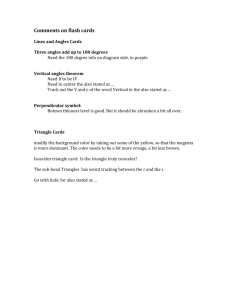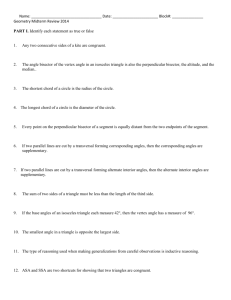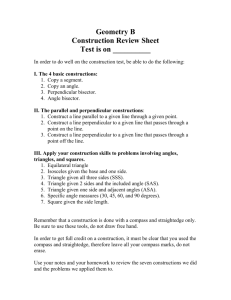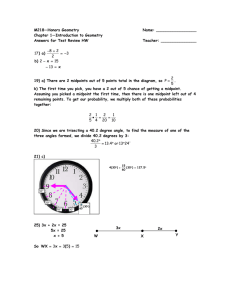Answers for Numbers 1-38
advertisement
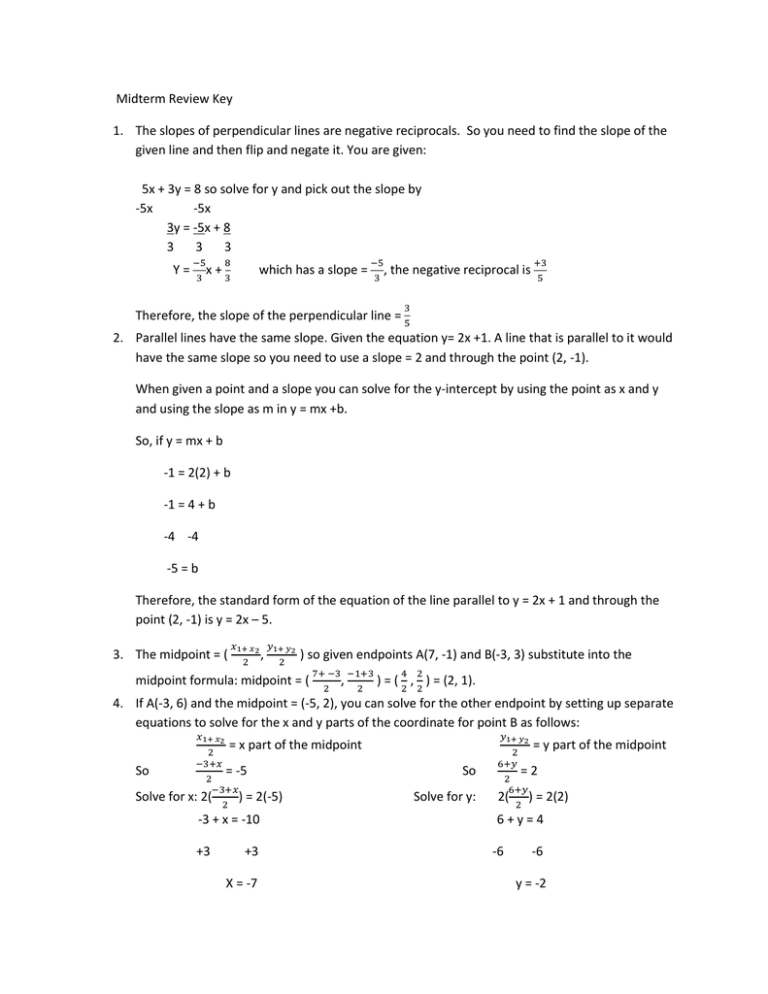
Midterm Review Key 1. The slopes of perpendicular lines are negative reciprocals. So you need to find the slope of the given line and then flip and negate it. You are given: 5x + 3y = 8 so solve for y and pick out the slope by -5x -5x 3y = -5x + 8 3 3 3 Y= −5 x 3 8 +3 which has a slope = −5 , 3 the negative reciprocal is Therefore, the slope of the perpendicular line = +3 5 3 5 2. Parallel lines have the same slope. Given the equation y= 2x +1. A line that is parallel to it would have the same slope so you need to use a slope = 2 and through the point (2, -1). When given a point and a slope you can solve for the y-intercept by using the point as x and y and using the slope as m in y = mx +b. So, if y = mx + b -1 = 2(2) + b -1 = 4 + b -4 -4 -5 = b Therefore, the standard form of the equation of the line parallel to y = 2x + 1 and through the point (2, -1) is y = 2x – 5. 3. The midpoint = ( 𝑥1+ 𝑥2 𝑦1+ 𝑦2 , 2 2 ) so given endpoints A(7, -1) and B(-3, 3) substitute into the midpoint formula: midpoint = ( 7+ −3 −1+3 , ) 2 2 4 2 2 2 = ( , ) = (2, 1). 4. If A(-3, 6) and the midpoint = (-5, 2), you can solve for the other endpoint by setting up separate equations to solve for the x and y parts of the coordinate for point B as follows: 𝑥1+ 𝑥2 So Solve So 2(-5) -3 + x = -10 +3 𝑦1+ 𝑦2 = x part of the midpoint 2 −3+𝑥 = -5 2 −3+𝑥 for x: 2( 2 ) = +3 X = -7 Solve for y: = y part of the midpoint 2 6+𝑦 =2 2 6+𝑦 2( 2 ) = 2(2) 6+y=4 -6 -6 y = -2 Therefore, the midpoint = (-7, -2). So, the answer for number 4 is choice 4. 5. Distance = √(𝑥1 − 𝑥2 )2 + (𝑦1 − 𝑦2 )2 = √(−1 − 3)2 + (4 − −2)2 = √(−4)2 + (6)2 = √16 + 36 = √52 = √4 x √13 = 2√13. Final answer 2√13. See the construction review packet for reference on any construction question 6. Choice 3 is the full illustration of the construction of an angle bisector. The other choices show incomplete illustrations of the construction. 7. Choice 1 is the complete illustration of the construction of the perpendicular bisector. 8. The illustration shows congruent corresponding angles. Choice 4 says “When two lines are intersected by a transversal and the corresponding angles are equal, the lines are parallel.”. Therefore, Choice 4 is the answer (the other choices don’t even mention congruent corresponding angles). 9. Choice 1 is the correct illustration. 10. The sum of the angles of a triangle = 180. So add the three expressions that are given and set the sum = 180. (3x + 1) + (4x -17) + (5x – 20) = 180 3x + 4x + 5x + 1 – 17 – 20 = 180 12x – 36 = 180 + 36 +36 12x = 216 12 12 X = 18 3x + 1 = 3(18) + 1 = 55 4x – 17 = 4(18) -17 = 55 5x – 20 = 5(18) -20 = 70 Since two angles = 55, the triangle is isosceles and choice 3 is the correct answer. (Note: a right triangle has a 90 degree angle, a scalene triangle has 3 different degree measures, and an equilateral triangle has all 3 angles = 60) 11. According to the diagram x = the vertex angle and 42 and y are the congruent base angles of the given isosceles triangle. So y = 42. If 42 + 42 + x = 180 84 + x = 180 -84 -84 Then, X = 96 So x = 96 and y = 42. Choice 4 is the correct answer. 12. The sum of the remote interior angles = The exterior angle of the triangle So, <A + <B = <ACD (x) + (2x +15) = 5x + 5 3x + 15 = 5x + 5 -3x -3x 15 = 2x + 5 -5 -5 10 = 2x 2 2 5=x So, <B = 2x + 15 = 2(5) + 15 = 25. Choice 3 is the correct answer. 13. The sum of the two smaller sides of the triangle must be greater than the length of the third side. So check the choices: 1) 2 + 4 is not greater than7 so a triangle cannot be made 2) 4 + 5 is greater than 6 and all three sides are different so this is the correct choice. It is possible and it is scalene. Choice 2 14. The sides opposite the smallest and largest angles correspond to the smallest and largest sides of the triangle respectively. We first need to find the measure of all three angles of the triangle, which must total 180 degrees. So, 70 + 65 + x = 180 135 + x = 180 -135 -135 X = 45 B 65 smallest side largest side A 45 70 C Medium Side So, BC < AC < AB is the correct order small to large Choice 3 is correct 15. Remember “My Parents Are Aliens” The circumcenter is found by constructing the perpendicular bisectors. So , choice 4 is correct. 16. The centroid divides the parts of each median in a 2:1 ratio. BF = 18 and is the length of the entire median so if So, choice 4 is correct. 18 3 = 6, then PF = 6 and BP = 12. 17. The sum of the interior angles of a polygon = 180(n – 2) (n represents the number of sides) A hexagon has 6 sides so, 180(6 -2) = 720 total We have 5 of the 6 angles 150 + 100 + 80 + 165 + 150 = 645 720 – 645 = 75 degrees for the remaining angle. Choice 1 is correct. 18. Each exterior angle of a regular polygon = 360 𝑛 = 360 5 = 72 So, choice 2 is correct. 19. Each interior angle of a regular polygon = In this case, 180(𝑛−2) 𝑛 180(𝑛−2) 𝑛 = 120 and we must solve for n. First cross multiply so that, Then distribute the 180 20. 21. 22. 23. 24. 25. 180(n – 2) = 120n 180n – 360 = 120n -120n -120n 60n – 360 = 0 + 360 +360 60n = 360 60 60 n = 6 sides If you plot (5, 2) on graph paper and rotate the paper 90 degrees in a counterclockwise direction, you will notice that the image of the point (5, 2) is now at (-2, 5). So, choice 3 is correct. (Alternatively, you can use the rule (x, y) → (-y, x) for a 90 degree counterclockwise rotation). If you plot the point (-3, 7) and reflect it across the x-axis you will see that the image of the point will now be at (-3, -7). Choice 2 is correct. (Alternatively, you can use the rule (x, y) → (x, -y) when reflecting the x-axis). If you plot (3, 4) and reflect it across the y-axis you will see the image of the point will now be at (-3, 4). Choice 2 is correct. (Alternatively, you can use the rule (x, y) → (-x, y) when reflecting the y-axis). Remember, it is difficult to count boxes diagonally across the line y = x so we used the rule: (x, y) → (y, x) when reflecting across the y = x line. In this case, (3, -4) → (-4, 3). Choice 4 is correct. If you plot the point (-3, -1) and rotate the paper 180 degrees you will see that the image of the point will now be at (3, 1). Choice 1 is correct. (Alternatively, you can use the rule (x, y) → (-x, -y) for a rotation of 180 degrees). Translations are achieved by adding the corresponding x and y parts of the translation vector to the x and y parts of the pre-image coordinate. In this case we must first figure out what translation vector would move P(3, 5) to 𝑃′ (6, 1). To get from 3 to 6 we must add 3. To get from 5 to 1 we must subtract 4. So, the translation vector used is <3, -4>. Now translate (-3, -5) along the vector <3, -4>. -3 + 3 = 0 and -5 + -4 = -9 So the image of the point winds up at (0, -9). Choice 1 is correct. 26. Starting at (4, 2) and first reflecting y=x (like #23) brings you to (2, 4) and then rotating that point by 90 degrees in the counterclockwise direction (like #20) brings us to a final image point of (-4, 2). Choice 1 is correct. 27. A dilation does not preserve distance so that is incorrect. A translation preserves both length and orientation so this is the correct answer. Choice 2. (Note: Line reflections and glide reflections do not preserve orientation. Second 27. Dilations change the size of the figure. So Choice 3 is correct. 28. Right 3 is achieved by adding 3 to x and down 7 is achieved by subtracting 7 from y. So, (x + 3, y – 7). Choice 1 is correct. (Note: as a vector (x + 3, y – 7) may be written as <3, -7>) 29. A median connects a vertex of a triangle to the midpoint on the opposite side. A midpoint divides a line segment into two congruent parts. The only choice that illustrates this point is choice 1. 30. A perpendicular bisector forms a 90 degree angle at the midpoint of a line segment. So, AC ≅ DC because AD is bisected at point C. BC may or may not be congruent to CD . Choice 2 is correct then. (Note: the angles in choice 3 are both 90 so they are congruent and the triangles can be proven congruent by SAS) 31. The negation of “Squares are parallelograms.” Is “It is not the case that squares are parallelograms.”. Choice 3 is correct. Second 31. An “AND” (Conjunction) statement is only true if both parts are true so we need a number that is not the square of an integer and a multiple of 3. 18 is a multiple of 3 and it is not the square of an integer so this is the correct answer. Choice 2. (Note: 9 IS the square of an integer, 32 is NOT a multiple of 3, and 36 IS the square of an integer) 32. An “OR” (Disjunction) statement is false only if both parts are false. We need a number that cannot be divided by 2 or 3. 11 is the only number that cannot be divided by 2 or 3 so this is the correct answer. Choice 3. (Note: 6 is divisible by both 2 and 3, 8 is divisible by 2, and 15 is divisible by 3) 33. If → Then (Conditional) statements are false only if the first part is true and the second part is false. So, we need a number that is divisible by 8 but not by 6. 32 fits this scenario. Choice 3 is correct. 34. The “Inverse” negates both parts of the conditional statement. So choice 3 is correct. 35. The “Converse” switches the order that the conditional statement is written. So choice 3 is correct. 36. The “Contrapositive” does both switch and negate. So choice 4 is correct. 37. The “Contrapositive” is the only one that is always “logically equivalent” to the original. So, choice 4 is correct. 38. The triangles given are already labelled so we can see that we need AG ≅ OL to give us SAS. So, choice 2 is correct. MARK THE TRIANGLES. 39.

